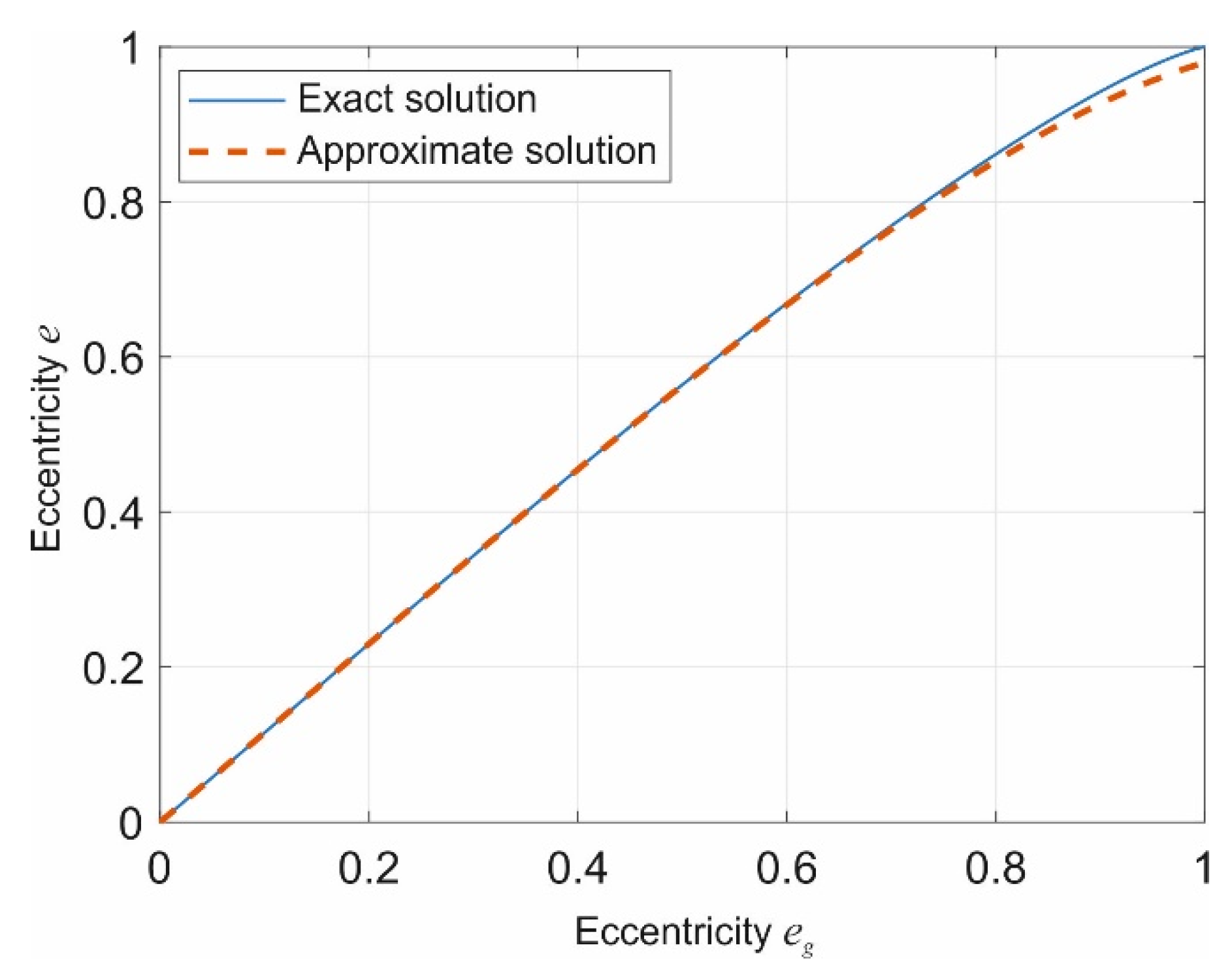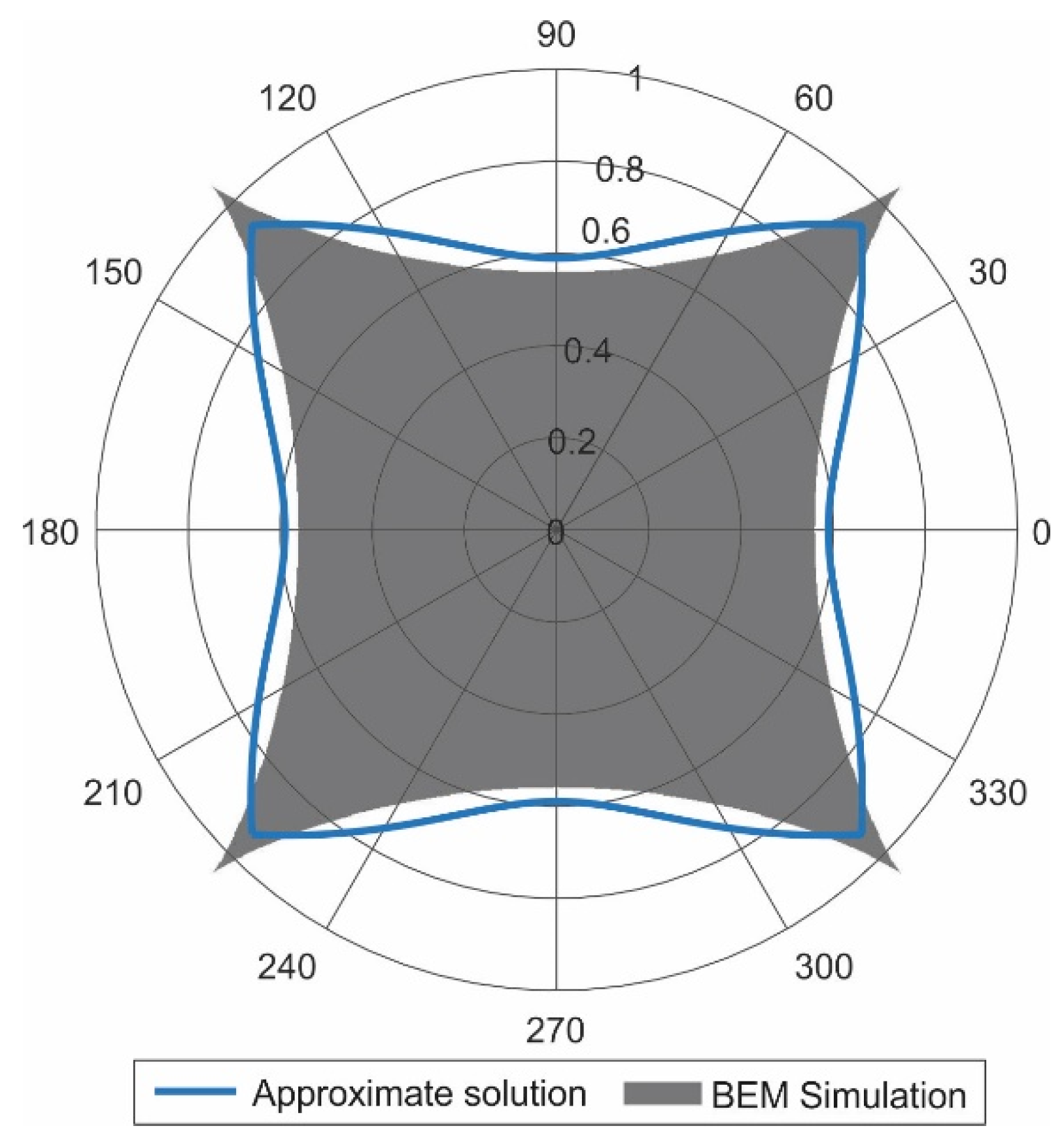An Approximate Solution for the Contact Problem of Profiles Slightly Deviating from Axial Symmetry
Abstract
:1. Introduction
2. Barber’s Extremal Principle
3. Finding the Force Maximum
3.1. Axially Symmetric Profiles
3.2. General Profiles
3.3. Profiles Slightly Deviating from Axisymmetric Ones
3.4. Pressure Distribution for Profiles Slightly Deviating from Axisymmetric Ones
4. Examples
4.1. Contact with Parabolic Profiles with Arbitrary Cross-Section
4.2. Contact with a Paraboloid
4.3. Contact of a Conical Indenter with an Arbitrary Cross-Section
4.4. Contact of a Pyramid with Square Cross-Section
4.5. Contact of Power-Law Shapes
5. Extended Method of Dimensionality Reduction (MDR) for Slightly Non-Axisymmetric Contacts
- (1)
- the profile deviates only weakly from an axisymmetric one;
- (2)
- during the normal indentation, only the normal contact force appears (no tilting forces or moments).
- I.
- In the first step, an “equivalent axisymmetric profile” is determined. In the first-order approximation, it was shown to be just the profile averaged over the angles:
- II.
- The profile can now be decomposed into an axisymmetric part and the small deviation
- III.
- With the equivalent axisymmetric profile (72), the usual MDR solution procedure is applied. In particular, the MDR-transformed profile is determined as
- IV.
- The effective radius is determined by the condition
- V.
- The normal force is given by the equation
- VI.
- The effective pressure distribution in the contact area is given by the usual MDR equation [14] (p. 9)
- VII.
- The true non-axisymmetric contact area is given by the equation
- VIII.
- Finally, the true pressure distribution is given by
6. Discussion
Funding
Institutional Review Board Statement
Informed Consent Statement
Data Availability Statement
Acknowledgments
Conflicts of Interest
References
- Hertz, H. Über die Berührung fester elastischer Körper. J. Für Die Reine Und Angew. Math. 1882, 92, 156–171. [Google Scholar] [CrossRef]
- Popova, E.; Popov, V.L. Ludwig Föppl and Gerhard Schubert: Unknown classics of contact mechanics. ZAMM-J. Appl. Math. Mech./Z. Für Angew. Math. Und Mech. 2020, 100, e202000203. [Google Scholar] [CrossRef]
- Föppl, L. Elastische Beanspruchung des Erdbodens unter Fundamenten. Forsch. Auf Dem Geb. Des Ing. A 1941, 12, 31–39. [Google Scholar] [CrossRef]
- Schubert, G. Zur Frage der Druckverteilung unter elastisch gelagerten Tragwerken. Ing.-Arch. 1942, 13, 132–147. [Google Scholar] [CrossRef]
- Barber, J.R.; Billings, D.A. An approximative solution for the contact area and elastic compliance of a smooth punch of arbitrary shape. Int. J. Mech. Sci. 1990, 32, 991–997. [Google Scholar] [CrossRef]
- Shield, R.T. Load-displacement relations for elastic bodies. Z. Für Angew. Math. Und Phys. ZAMP 1967, 18, 682–693. [Google Scholar] [CrossRef]
- Barber, J.R. Determining the contact area in elastic indentation problems. J. Strain Anal. 1974, 9, 230–232. [Google Scholar] [CrossRef]
- Fabrikant, V.I. Flat punch of arbitrary shape on an elastic half-space. Int. J. Eng. Sci. 1986, 24, 1731–1740. [Google Scholar] [CrossRef]
- Barber, J.R. Contact Mechanics; Springer: Cham, Switzerland, 2018; p. 585. [Google Scholar] [CrossRef]
- Popov, V.L. Contact Mechanics and Friction. Physical Principles and Applications, 2nd ed.; Springer: Berlin/Heidelberg, Germany, 2017. [Google Scholar] [CrossRef]
- Popov, V.L.; Heß, M. Method of Dimensionality Reduction in Contact Mechanics and Friction; Springer: Berlin/Heidelberg, Germany, 2015; 265p. [Google Scholar] [CrossRef]
- Li, Q.; Technische Universität, Berlin, Germany. Personal Communication, 2022.
- Pohrt, R.; Li, Q. Complete boundary element formulation for normal and tangential contact problems. Phys. Mesomech. 2014, 17, 334–340. [Google Scholar] [CrossRef]
- Popov, V.L.; Heß, M.; Willert, E. Handbook of Contact Mechanics. Exact Solutions of Axisymmetric Contact Problems; Springer: Berlin/Heidelberg, Germany, 2019. [Google Scholar] [CrossRef]
- Golikova, S.S.; Mossakovskii, V.I. Pressure of a plane stamp of nearly circular cross section on an elastic half-space. PMM J. Appl. Math. Mech. 1976, 40, 1085–1088. [Google Scholar] [CrossRef]

Publisher’s Note: MDPI stays neutral with regard to jurisdictional claims in published maps and institutional affiliations. |
© 2022 by the author. Licensee MDPI, Basel, Switzerland. This article is an open access article distributed under the terms and conditions of the Creative Commons Attribution (CC BY) license (https://creativecommons.org/licenses/by/4.0/).
Share and Cite
Popov, V.L. An Approximate Solution for the Contact Problem of Profiles Slightly Deviating from Axial Symmetry. Symmetry 2022, 14, 390. https://doi.org/10.3390/sym14020390
Popov VL. An Approximate Solution for the Contact Problem of Profiles Slightly Deviating from Axial Symmetry. Symmetry. 2022; 14(2):390. https://doi.org/10.3390/sym14020390
Chicago/Turabian StylePopov, Valentin L. 2022. "An Approximate Solution for the Contact Problem of Profiles Slightly Deviating from Axial Symmetry" Symmetry 14, no. 2: 390. https://doi.org/10.3390/sym14020390
APA StylePopov, V. L. (2022). An Approximate Solution for the Contact Problem of Profiles Slightly Deviating from Axial Symmetry. Symmetry, 14(2), 390. https://doi.org/10.3390/sym14020390






